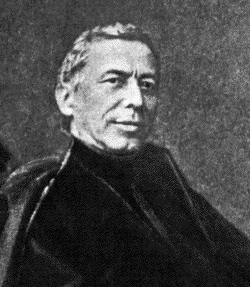Secchi, Rev. Pietro Angelo (1818–1878)

Mica schist. Credit: U.S. National Parks Service.
Pietro Secchi was a prolific Italian astronomer, pioneer of stellar spectroscopy, Jesuit priest, and director of the Roman College Observatory (the forerunner of today's Vatican Observatory). Secchi was born in Reggio, joined the Jesuits at age 15, began his theological studies in 1844, and was ordained priest in 1847. In 1839 he began lecturing on physics and mathematics at the Jesuits' Collegio Romano. In 1848, due to the political unrest in Italy that led to the general expulsion of the Jesuit order, he traveled to England, then to Georgetown University, near Washington, where he taught the natural sciences. He was back in Europe within a year, and in 1852 returned to Rome, founding a new observatory at the Collegio Romano. He remained based in Rome until his death.
Secchi made many important contributions to the astronomy of his day, in particular on stellar spectral classification. He was the first to make systematic use of spectroscopy in stellar classification. His four class scheme prevailed throughout much of the second half of the 19th century, and paved the way for all later classification schemes. Secchi was also extremely active in solar physics, an area he became interested in during his stay in America. He studied prominences during eclipses, both visually and spectroscopically, and provided the first demonstrations that prominences are features belonging to the Sun. He wrote a number of astronomical books in Italian, some quite technical, others aimed at the general public, and one for children. His influential solar monograph Le Soleil was first published in Paris in 1870, with a German translation appearing in 18XX and the second French edition in 1875.
Secchi was the first astrophysicist to suggest that the solar core is in a gaseous state, with the temperature steadily decreasing from the center to the surface. Some of his theories on sunspots, granulation, and prominences would today be considered obsolete, but their influence on 19th century astronomy and solar physics was considerable. He was elected to England's Royal Society and Royal Astronomical Society, of the French Académie des Sciences, and of Russia's Imperial Academy of St. Petersburg. In Italy he presided for many years over the Accademia dei Nuovi Lincei, and founded the Societa degli Spettroscopisti Italiani, devoted to spectroscopic studies of the Sun.
Secchi saw his religion as being fully compatible with pluralism. In 1856, he wrote:
It is with sweet sentiment that man thinks of these worlds without number, where each star is a sun which, as minister of the divine bounty, distributes life and goodness to the other innumerable beings, blessed by the hand of the Omnipotent.
In fact, Secchi was such a committed pluralist that he often seemed to ignore the evidence of his own research. He was the first to classify stars according to their spectra and therefore knew as well as anyone how different they could be. Between 1863 and 1867, before the introduction of photography, Secchi carried out a remarkable study of the spectra of some 4,000 stars, using a visual spectroscope on the Roman College Observatory's telescope. He noted the absorption-line (dark-line) spectra of the stars, and developed a four-category classification scheme that was later refined into the currently used Draper classification.Yet still he concluded:
The atmospheric constitution of the other planets which, in certain points, is so similar to ours as that of the stars is similar to that of the sun, persuades us that these bodies are in a state similar to that of our system ...
In 1859, Secchi became the first to use the term canali to describe two fine lines he had seen on the surface of Mars (see Mars, canals).


